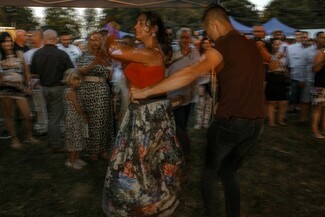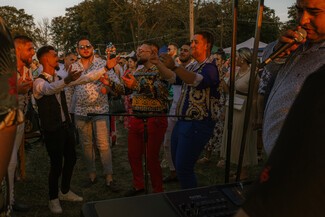Romani Dance

For centuries Romani tribes have passed down their traditions through stories shared over the yog. This makes it quite hard to find written documentation of exactly when Romani people started to use art forms like dance and music to express themselves. Research shows there is little written evidence to pinpoint when Romani dance originated or what it looked like before the 12th - 14th century, as the Romani people arrived in Europe.
The ‘Dance’ section of the RomArchive (a digital archive of Roma art and cultural history) notes that the push and pull of Romani people travelling West from Northern India has resulted in various dance styles that have influenced Turkish, Spanish and Russian dance forms, and many more.
Many of the Romani Dances today have obvious common movements that include spinning and twirling, direct footwork and stomping, shoulder movements, and flamboyant arm work.
The influence on Spanish Roma is especially important as it resulted in the art form Flamenco. The ‘Flamenco’ section of the RomArchive states, Flamenco is a Roma art form and artefacts depicting Romani Flamenco dancers show that the Gitano (meaning Spanish Roma) from the Andalusia regions had a direct influence on how Flamenco came to be. The influence was sourced from the everyday life of Romani people in Southern Spain. Through gestures, poems, music, dance and emotions, Flamenco took its physical form.
The Judith Cohen Collection in the RomArchvie shows how Romani migration to East Europe saw the influence of Cocek: a Balkan Romani Dance. Both Spanish Flamenco and Cocek share similar styles. Both dances often involve proud, upright postures with isolated movements of the upper body. Arms might be held high or used for expressive gestures. Also, Flamenco and Balkan Romani dances are known for conveying emotions through body language. Sharp arm movements, head tilts, and hand gestures can express passion, defiance or joy.

A commonality when looking at many Romani Dance styles in Europe often involves improvisation and a strong connection between the dancer and the music. Dancers tend to respond to the rhythm and emotions carried by the musicians. The Romani people have a rich cultural history of expressing themselves through dance, music and other art forms, as a fundamental part of their social and cultural life. Romani dance has never been a fixed form but rather a living tradition that continues to develop and evolve.
By Liza Mortimer
(Photographs: Czatka pilgrimage, Hungary, 2023 © Eszter Halasi)
This article first appeared in the Spring/Summer 2024 issue of the Travellers’ Times Magazine. You can subscribe to the next issue – which is out in November – by following this link.